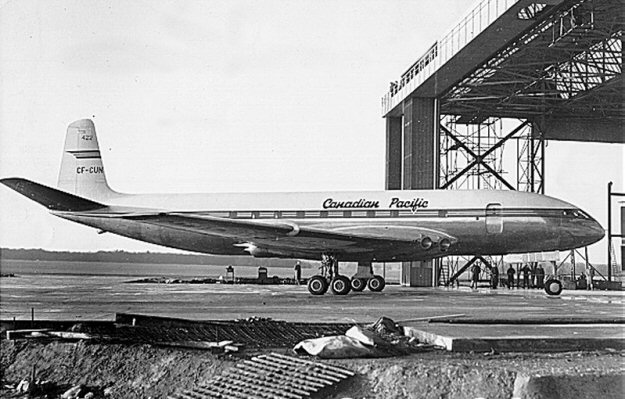CF-CUN de
Havilland D.H.106 Comet 1A (c/n 06104)

Seen above is the ill fated Comet with which CPAL hoped to
initiate trans-Pacific jet services.
The Comet 1A model, 10 of which were
built, was an increased fuel variation with the capability
of having
water methanol injection. The above photograph was acquired from
de Havillands in
1953. For some reason, the publicity images issued by D.H. were
never of very good quality.
Anyway, even with the increased range, Canadian Pacific
knew they could not fly the Comet on
the long
overwater route from Vancouver to Hawaii, so planned on basing the
Comets in Sydney
and
using them as far as Honolulu, whereupon passengers would be
transferred to DC-6Bs to
continue their journey to Canada. CF-CUN, named "Empress of
Hawaii" was, then, on its
initial positioning flight going out to Australia. On 3 March
1953 the aircraft did not become
airborne
on take off from Karachi Airport and crashed into the dry bed of a
river. This constituted
the
first passenger jetliner involved in a fatal accident. An excerpt
from the Accident Report reads
as
follows:
"The accident was caused by the fact that the nose
of the aircraft was lifted too high during
the takeoff run, resulting in a partially stalled condition and
excessive drag. This did not
permit normal acceleration and prevented the aircraft from becoming
airborne within the
prescribed distance. The pilot appears to have realized that the nose
was excessively high
and
took corrective action, but this was done too late to prevent the
aircraft striking an
obstruction immediately beyond the perimeter fence before it became
airborne. The pilot,
who had
only limited experience in the Comet aircraft, elected to takeoff at
night at the
maximum
permissible takeoff for the prevailing conditions. The circumstances
required
strict
adherence to the prescribed takeoff technique, which was not complied
with."
